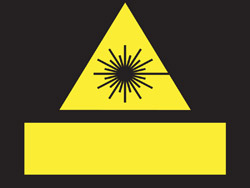
Lasers have been classified with respect to their hazards based on power, wavelength, and pulse duration. This label provides important information on the hazard of the laser. These pulses will have enormous peak powers often in the range from 10(12) Watts peak.Ī classification label will be found on the laser housing. A mode-locked laser can deliver extremely high peak powers than the same laser operating in the Q-switched mode. Lasers operating in this mode-locked fashion, usually produce a train of regularly spaced pulses, each having a duration of 10(-15) (femto) to 10(-12) (pico) sec. The result is a laser output which is observed as regularly spaced pulsations. When the phases of different frequency modes are synchronized, i.e., "locked together," the different modes will interfere with one another to generate a beat effect. MODE LOCKED lasers operate as a result of the resonant modes of the optical cavity which can affect the characteristics of the output beam.The direction of a CW laser can be scanned rapidly using optical scanning systems to produce the equivalent of a repetitively pulsed output at a given location. REPETITIVELY PULSED or scanning lasers generally involve the operation of pulsed laser performance operating at a fixed (or variable) pulse rates which may range from a few pulses per second to as high as 20,000 pulses per second.These pulses will have high peak powers often in the range from 10(6) to 10(9) Watts peak. Then, under optimum gain conditions, emission occurs in single pulses typically of 10(-8) second time domain. SINGLE PULSED Q-SWITCHED lasers are the result of an intracavity delay (Q-switch cell) which allows the laser media to store a maximum of potential energy.This mode of operation is sometimes referred to as long pulse or normal mode. SINGLE PULSED (normal mode) lasers generally have pulse durations of a few hundred microseconds to a few milliseconds.In low power gas lasers, such as HeNe, the power level is fixed by design and performance usually degrades with long term use. In most higher-power systems, one is able to adjust the power.


CONTINUOUS WAVE (CW) lasers operate with a stable average beam power.Energy is built-up in a Q-Switched laser and released by opening the device to produce a single, intense laser pulse.

A Q-Switched laser is a pulsed laser which contains a shutter-like device that does not allow emission of laser light until opened. Lasers are also characterized by the duration of laser emission - continuous wave or pulsed laser. They may be built into larger arrays, e.g., the writing source in some laser printers or compact disk players. These electronic devices are generally very small and use low power. Semiconductor lasers, sometimes called diode lasers, are not solid-state lasers.

They are tunable over a broad range of wavelengths. When electrically stimulated, a pseudomolecule or dimer is produced and when lased, produces light in the ultraviolet range.ĭye lasers use complex organic dyes like rhodamine 6G in liquid solution or suspension as lasing media. CO 2 lasers emit energy in the far-infrared, 10.6 micrometers, and are used for cutting hard materials.Įxcimer lasers (the name is derived from the terms excited and dimers) use reactive gases such as chlorine and fluorine mixed with inert gases such as argon, krypton, or xenon. Gas lasers (helium and helium-neon, HeNe, are the most common gas lasers) have a primary output of a visible red light. The neodymium-YAG laser emits infrared light at 1.064 micrometers. Solid state lasers have lasing material distributed in a solid matrix, e.g., the ruby or neodymium-YAG (yttrium aluminum garnet) lasers. Lasers are often described by the kind of lasing medium they use - solid state, gas, excimer, dye, or semiconductor. There are many types of lasers available for research, medical, industrial, and commercial uses.


 0 kommentar(er)
0 kommentar(er)
